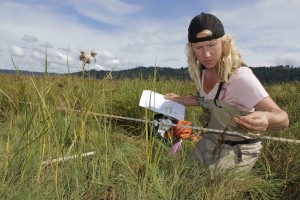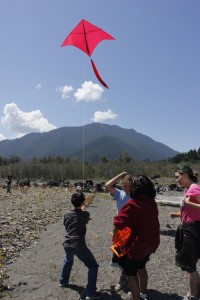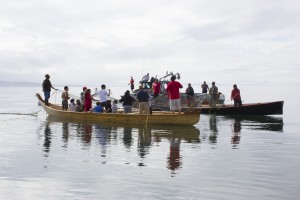Source: Indian Country Today Media Network
The following remarks were delivered by Tony West, associate attorney general at the Native American Issues Subcommittee (NAIS) meeting on September 18 in Hood River, Oregon.
Thank you, Karol, for that kind introduction. Karol is one of the leading advocates for tribes at the Department of Justice, and I’m delighted that she has taken the helm at OJP.
Let me thank Tim [Purdon, NAIS Chair] and Sandy [Coats, NAIS Vice Chair] for their very capable leadership of the Native American Issues Subcommittee, and for all they do to coordinate the Department’s efforts with its tribal partners. I also want to thank Amanda [Marshall, USA for the District of Oregon] and the many tribal leaders for hosting us. I’m honored to be here among you. Thanks, too, to Marshall Jarrett for his leadership at the Executive Office of U.S. Attorneys and Tracy Toulou for the exceptional work he does as Director of our Office of Tribal Justice. Finally, I extend my appreciation to all the members of the committee for your hard work and commitment to these very important issues.
I’m very pleased to have this chance to meet with the federal and tribal officials responsible for the safety and welfare of Native communities and to talk about ways we can continue working together to strengthen the Justice Department’s work in Indian country. We have made unprecedented strides – and achieved remarkable success – in improving law enforcement and ensuring justice in American Indian and Alaska Native communities, and I want to ensure that we build on our progress.
The progress has been tremendous.
Every U.S. Attorney with jurisdiction in Indian country has now appointed at least one tribal liaison, and we’ve designated a Native American Issues Coordinator to provide advice and assistance to U.S. Attorneys’ Offices on legal and policy issues. We created the Tribal Nations Leadership Council to advise the Attorney General on issues critical to tribal governments. We launched the National Indian Country Training Initiative, which last year trained some 2,500 federal, state, and tribal criminal justice professionals on issues ranging from domestic violence to wildlife and pollution enforcement. We created a Violence Against Women Federal and Tribal Prosecution Task Force and assigned additional federal personnel to investigate and prosecute cases on Indian lands. And we established the Office of Tribal Justice as a permanent component within the Justice Department.
We have also met – and exceeded – our responsibilities under the Tribal Law and Order Act. We published a final rule that authorizes the Department to assume concurrent jurisdiction over certain crimes committed in Public Law 280 states, and we have already exercised that authority. We’re enhancing our efforts to combat sexual assault by expanding support for Sexual Assault Nurse Examiners and Sexual Assault Response Teams in Indian country and by establishing a SANE/SART Advisory Committee. We’ve settled long-standing trust litigation and boundary disputes to the benefit of tribes. We’ve worked to protect water rights and natural resources on tribal lands and helped preserve Native cultural and religious practices. We’ve joined with our federal partners to develop, in consultation with tribes, a long-term plan to build and sustain tribal justice systems. And we’re fighting alcohol and substance abuse by coordinating services with the Departments of the Interior and Health and Human Services and by providing assistance to tribes that want to develop action plans to address these issues.
Finally, we’ve vastly expanded and strengthened our outreach to tribes. I have had the honor of joining the Attorney General, the Deputy Attorney General, and many other leaders in the Department at a number of listening sessions and consultations in Indian country. Attorney General Holder approved a policy statement committing the Department to regular and meaningful consultation and collaboration with tribal officials. This policy statement requires the Department to seek tribal input whenever we develop or amend policies, regulations, or legislation that will affect tribes. In addition, staff from across the Justice Department have partnered with their colleagues in the Departments of the Interior, Health and Human Services, HUD, and other agencies to hold tribal justice, safety, and wellness training and technical assistance sessions, where we’ve reached more than 5,500 participants. As a result of this greater coordination and cooperation, we’ve been able to more effectively target our resources to meet the most pressing public safety needs of tribes.
Through our Coordinated Tribal Assistance Solicitation, or CTAS as we call it, we’ve revamped and streamlined the process for tribes to tap much-needed federal funding. We’ve heard from tribes that this mechanism has been an important positive step in our relationship with tribes, and we continue to make it a centerpiece of our efforts to support tribal communities.
In fact, today I’m pleased to announce that the Department of Justice is awarding almost 200 new awards totaling more than $90 million under CTAS. These awards bring the total number of grants to tribes over the last four years to almost 1,000, totaling almost $440 million. These grants address an array of tribal justice system issues, from at-risk youth and violence against women to community policing and corrections alternatives, and they give tribes the support they need to keep their communities safe and ensure a just, fair, and effective system for fighting crime.
But there is more we must do. Violence against Native women continues at alarming rates, and children in Indian country encounter violence far too often.
I was proud to witness President Obama sign the reauthorization of the Violence Against Women Act in March. This landmark legislation provides vital protections for all women, but it is especially important for what it does to help ensure the safety of Indian women. Now, thanks to the new law, tribes may exercise jurisdiction over certain crimes committed by non-Indians on their lands. This represents a giant step forward in our ability to hold perpetrators of domestic and dating violence accountable.
And we must do all we can to protect Indian children. More than 60 percent of kids in America encounter some form of violence, crime, or abuse, ranging from brief encounters as witnesses to serious violent episodes as victims. Almost 40 percent are direct victims of two or more violent acts. Tribal communities are no exception to this troubling phenomenon. As one tribal leader said, “For us. . . the question is not who has been exposed to violence, it’s who hasn’t been exposed to violence.”
As part of his Defending Childhood Initiative, Attorney General Holder established a national task force to study this problem and recommend ways to address it. One of the recommendations was the creation of a separate task force devoted specifically to children exposed to violence in Indian country. I’m pleased that work is well under way to stand up this task force, which includes both an advisory committee and a federal working group composed of U.S. Attorneys and other government officials, including our partners at the Department of the Interior, working in Indian country.
We anticipate that the Advisory Committee will convene hearings and listening sessions throughout the country and prioritize consultation with American Indian and Alaska Native youth. Our goal is to develop a national strategy to reduce and mitigate the impact of violence on children in tribal communities.
The Federal Working Group of the Task Force is already hard at work and making real progress. In an effort to ensure that juveniles held in tribal or Bureau of Indian Affairs detention facilities are provided adequate and culturally-sensitive educational and counseling services, the working group initiated a close look at existing programs and services. As a result, BIA has ensured that contracts for teachers are secured for detention facilities in Towoac, Colorado, and Northern Cheyenne, Montana. To ensure that Bureau of Prison contract facilities provide culturally appropriate services to tribal youth in detention, the working group completed a survey of programs currently available and is currently analyzing the results to develop best practices to ensure consistency across facilities. These are just a few of many efforts currently underway.
This is my sixth trip to Indian country since joining the Department of Justice as a member of President Obama’s administration in 2009, and my fourth as the Associate Attorney General. Since my first trip to the Navajo Nation, where I met with brave Cold War Warriors, I have traveled from the Crow Nation and Northern Cheyenne in Montana to the Southern Ute, Ute Mountain Ute, Acoma and Laguna Pueblos of the Four Corners. Earlier this month, I visited the Tulalip Tribes in Washington, and I am so pleased to join you today here in Celilo Village.
For me, these visits to Indian country are a great privilege. They are a great privilege for me because they remind me of the rich legacy that First Americans have bestowed upon this country, and that we are a stronger America because of that legacy.
They remind me of the important trust relationship between the United States and tribal nations, and that the struggle for tribal sovereignty and self-determination has too often been waged in the face of disruption and devastation caused by assimilation and termination policies pursued in the not-so-distant past.
The work we’ve done to strengthen public safety in Indian country – and the work we are doing to protect tribal sovereignty – is a collective responsibility, one that we all must share, federal and tribal officials alike. I’m pleased with what we’ve been able to accomplish thus far. I believe we have written a great chapter in the story of our government-to-government relationship with tribes. I look forward to working with all of you to continue that story into the next – and even greater – chapter.
Thank you.
Read more at http://indiancountrytodaymedianetwork.com/2013/09/22/tony-west-addresses-native-american-issues-subcommittee-151378















